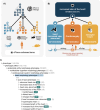This is a preprint.
The Unified Phenotype Ontology (uPheno): A framework for cross-species integrative phenomics
- PMID: 39345458
- PMCID: PMC11429889
- DOI: 10.1101/2024.09.18.613276
The Unified Phenotype Ontology (uPheno): A framework for cross-species integrative phenomics
Update in
-
The Unified Phenotype Ontology : a framework for cross-species integrative phenomics.Genetics. 2025 Mar 17;229(3):iyaf027. doi: 10.1093/genetics/iyaf027. Genetics. 2025. PMID: 40048704 Free PMC article.
Abstract
Phenotypic data are critical for understanding biological mechanisms and consequences of genomic variation, and are pivotal for clinical use cases such as disease diagnostics and treatment development. For over a century, vast quantities of phenotype data have been collected in many different contexts covering a variety of organisms. The emerging field of phenomics focuses on integrating and interpreting these data to inform biological hypotheses. A major impediment in phenomics is the wide range of distinct and disconnected approaches to recording the observable characteristics of an organism. Phenotype data are collected and curated using free text, single terms or combinations of terms, using multiple vocabularies, terminologies, or ontologies. Integrating these heterogeneous and often siloed data enables the application of biological knowledge both within and across species. Existing integration efforts are typically limited to mappings between pairs of terminologies; a generic knowledge representation that captures the full range of cross-species phenomics data is much needed. We have developed the Unified Phenotype Ontology (uPheno) framework, a community effort to provide an integration layer over domain-specific phenotype ontologies, as a single, unified, logical representation. uPheno comprises (1) a system for consistent computational definition of phenotype terms using ontology design patterns, maintained as a community library; (2) a hierarchical vocabulary of species-neutral phenotype terms under which their species-specific counterparts are grouped; and (3) mapping tables between species-specific ontologies. This harmonized representation supports use cases such as cross-species integration of genotype-phenotype associations from different organisms and cross-species informed variant prioritization.
Conflict of interest statement
7.Conflict of Interest None declared.
Figures




References
-
- Fisher S. E. & Scharff C. FOXP2 as a molecular window into speech and language. Trends Genet. 25, 166–177 (2009). - PubMed
Publication types
Grants and funding
- P41 HG000330/HG/NHGRI NIH HHS/United States
- U24 HG010859/HG/NHGRI NIH HHS/United States
- R24 OD011883/OD/NIH HHS/United States
- UM1 HG006370/HG/NHGRI NIH HHS/United States
- WT_/Wellcome Trust/United Kingdom
- RM1 HG010860/HG/NHGRI NIH HHS/United States
- U24 HG002659/HG/NHGRI NIH HHS/United States
- U41 HG001315/HG/NHGRI NIH HHS/United States
- R01 DA028420/DA/NIDA NIH HHS/United States
- U24 HG012542/HG/NHGRI NIH HHS/United States
- U41 HG002273/HG/NHGRI NIH HHS/United States
- P41 HD064556/HD/NICHD NIH HHS/United States
- U24 HG011449/HG/NHGRI NIH HHS/United States
- U54 OD030187/OD/NIH HHS/United States
LinkOut - more resources
Full Text Sources
